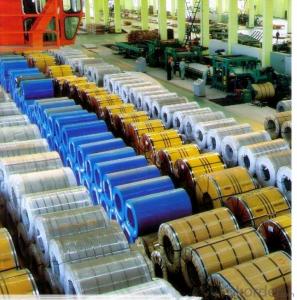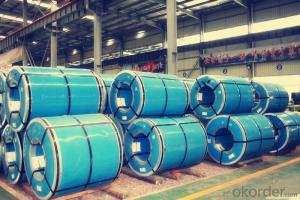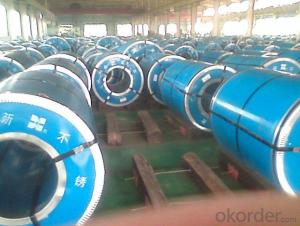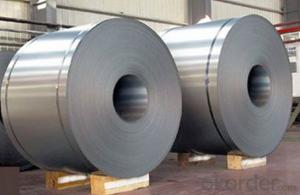Stainless Steel Coil 304 Surface No.1 Hot Rolled Coil
- Loading Port:
- Guangzhou
- Payment Terms:
- TT OR LC
- Min Order Qty:
- 100 m.t.
- Supply Capability:
- 5000 m.t./month
OKorder Service Pledge
OKorder Financial Service
You Might Also Like
Hot Rolled Stainless Steel Coil 304 Annealing and Pickling No.1 Finish
Stainless steel is a production which not easy rust,acid resistance and corrosion resistance,so it is widely
used in light industry,heavy industry,daily necessities and the decoration industry.
Hot Rolled Stainless Steel Coil 304 Specifications
1.surface:NO.1
2.standard:JIS, AISI, GB
3.width: 0.55m, 0.65m, 1.0m, 1.22m, 1.5m, 2m or requirement
Hot Rolled Stainless Steel Coil 304 Chemical Composition:
(%):C=0.07, Mn=2.00, P=0.045, S=0.030, Si=0.075, Cr=17.5-19.5, Ni=8.0-10.5, N=0.10
Hot Rolled Stainless Steel Coil 304 Physical Properties
Tensile strength σb (MPa) ≥ 520
the conditions yield strength σ0.2 (MPa) ≥ 205,
elongation δ5 (%) ≥ 40
Reduction of ψ (%) ≥ 50,
hardness: ≤ 187
HB; ≤ 90
HRB; ≤ 200H
- Q:Are stainless steel strips suitable for industrial ovens?
- Yes, stainless steel strips are suitable for industrial ovens. Stainless steel is a highly durable and heat-resistant material that can withstand high temperatures typically found in industrial oven environments. It is also resistant to corrosion and oxidation, making it ideal for prolonged exposure to heat. Additionally, stainless steel strips are easy to clean and maintain, making them a practical choice for industrial oven applications.
- Q:Are stainless steel strips suitable for laser cutting?
- Yes, stainless steel strips are suitable for laser cutting.
- Q:Are stainless steel strips suitable for architectural facades?
- Yes, stainless steel strips are suitable for architectural facades. They offer a sleek and modern appearance, excellent durability, and resistance to corrosion, making them an ideal choice for both indoor and outdoor applications. Additionally, stainless steel can be easily manipulated into various shapes and sizes, allowing for creative and unique designs in architectural facades.
- Q:Can stainless steel strips be used in telecommunications applications?
- Telecommunications applications can indeed make use of stainless steel strips. The reason for this is that stainless steel possesses exceptional corrosion resistance and durability, rendering it appropriate for diverse industries, including telecommunications. Its usefulness in telecommunications extends to various applications such as cable trays, cable conduits, antenna brackets, enclosures, and support structures. Due to their high strength-to-weight ratio, ability to withstand extreme temperatures, and capacity for electromagnetic interference (EMI) shielding, stainless steel strips are frequently favored in telecommunications. Furthermore, they can be readily fabricated and tailored to meet specific needs, making them a versatile option for telecommunications applications.
- Q:Can stainless steel strips be used in the food packaging industry?
- Yes, stainless steel strips can be used in the food packaging industry. Stainless steel is a highly durable and corrosion-resistant material that meets the hygiene standards required for food packaging. It provides a strong and reliable packaging solution, ensuring the safety and freshness of the food products.
- Q:Do stainless steel strips require any special handling or storage?
- Yes, stainless steel strips do require special handling and storage to maintain their quality and prevent damage. Here are some key considerations: 1. Handling: Stainless steel strips should be handled with care to avoid scratches, dents, or other forms of physical damage. It is recommended to use gloves and protective equipment to prevent any contamination from oils, dirt, or fingerprints. 2. Storage: Stainless steel strips should be stored in a clean, dry, and well-ventilated area to prevent corrosion. They should be kept away from moisture, chemicals, and any other substances that could cause damage. Ideally, the storage location should have a controlled temperature and humidity level. 3. Protection: To ensure the longevity of stainless steel strips, they should be protected from contact with other metals or abrasive materials. Storing them separately or using appropriate packaging, such as plastic or paper interleaved between the strips, can help prevent scratches or other damages. 4. Handling equipment: When moving or transporting stainless steel strips, it is advisable to use equipment specifically designed for handling metal products. This can include lifting devices, slings, or clamps that ensure proper support and avoid any bending or deformation of the strips. 5. Regular inspection: Regularly inspecting stainless steel strips for any signs of damage, corrosion, or deterioration is essential. Any issues should be addressed promptly to prevent further degradation and maintain the quality of the strips. By following these guidelines, stainless steel strips can be stored and handled properly, ensuring their integrity and allowing for their successful application in various industries.
- Q:What are the common chemical compositions of stainless steel strips?
- Stainless steel strips are typically composed of iron, chromium, and nickel. The most common chemical composition of stainless steel strips is 18% chromium and 8% nickel, known as 18/8 stainless steel. This composition provides excellent corrosion resistance, making stainless steel strips suitable for various applications, including kitchen utensils, automotive parts, and construction materials. Additionally, other elements such as carbon, manganese, and molybdenum may be present in smaller amounts to enhance specific properties such as strength, formability, and weldability. Overall, the chemical compositions of stainless steel strips can vary depending on the specific grade and intended use, but the presence of chromium and nickel is consistent across most stainless steel alloys.
- Q:What is the maximum temperature resistance of stainless steel strips?
- The maximum temperature resistance of stainless steel strips largely depends on the specific grade of stainless steel being used. However, in general, stainless steel has excellent heat resistance properties and can withstand high temperatures without significant deformation or loss of strength. Most standard stainless steel grades, such as 304 and 316, can typically withstand temperatures up to 1500°F (815°C) without any major issues. However, there are certain specialized stainless steel grades, such as 310 and 330, which offer even higher temperature resistance, reaching up to 2100°F (1150°C) and 2200°F (1200°C) respectively. It is important to note that the maximum temperature resistance of stainless steel can also be influenced by factors such as exposure time, the presence of corrosive agents, and the specific application. Therefore, it is always recommended to consult with the manufacturer or a material specialist to determine the maximum temperature resistance of stainless steel strips for a specific application or environment.
- Q:Can 111 stainless steel strips be perforated for filtration applications?
- Yes, 111 stainless steel strips can be perforated for filtration applications. Perforating stainless steel strips allows for the creation of fine holes or slots, which are essential for filtration purposes. The size and pattern of the perforations can be customized to meet specific filtration requirements. Stainless steel is often chosen for filtration applications due to its durability, corrosion resistance, and ability to withstand high temperatures. Therefore, utilizing 111 stainless steel strips for perforation can provide an effective solution for various filtration needs.
- Q:What is the average lifespan of stainless steel strips?
- The average lifespan of stainless steel strips can vary depending on several factors, such as the grade and quality of the stainless steel, the environment in which the strips are used, and the level of maintenance and care they receive. In general, stainless steel is known for its durability and corrosion resistance, which can contribute to a longer lifespan compared to other materials. Stainless steel strips that are properly maintained and used in non-corrosive environments can last for several decades. However, if the strips are exposed to harsh chemicals, high temperatures, or abrasive conditions, their lifespan may be shortened. Regular cleaning and maintenance, such as removing any accumulated dirt or debris, can also help prolong the lifespan of stainless steel strips. It is important to note that the average lifespan is just an estimate and can vary depending on the specific application and usage conditions. If you are looking to use stainless steel strips for a specific project, it is recommended to consult with a professional who can provide more accurate information based on your specific requirements.
1. Manufacturer Overview |
|
|---|---|
| Location | |
| Year Established | |
| Annual Output Value | |
| Main Markets | |
| Company Certifications | |
2. Manufacturer Certificates |
|
|---|---|
| a) Certification Name | |
| Range | |
| Reference | |
| Validity Period | |
3. Manufacturer Capability |
|
|---|---|
| a)Trade Capacity | |
| Nearest Port | |
| Export Percentage | |
| No.of Employees in Trade Department | |
| Language Spoken: | |
| b)Factory Information | |
| Factory Size: | |
| No. of Production Lines | |
| Contract Manufacturing | |
| Product Price Range | |
Send your message to us
Stainless Steel Coil 304 Surface No.1 Hot Rolled Coil
- Loading Port:
- Guangzhou
- Payment Terms:
- TT OR LC
- Min Order Qty:
- 100 m.t.
- Supply Capability:
- 5000 m.t./month
OKorder Service Pledge
OKorder Financial Service
Similar products
New products
Hot products
Related keywords































